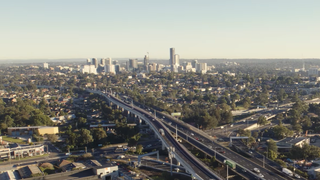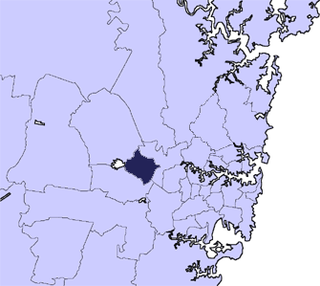
Parramatta is a major commercial suburb of the City of Parramatta, in Greater Sydney which is located in the state of New South Wales, Australia. It is located approximately 23 kilometres (14 mi) west of the Sydney central business district on the banks of the Parramatta River. Parramatta is the administrative seat of the City of Parramatta and is often regarded as commercial centre for both the Greater Parramatta region as well as the broader Greater Western Sydney region.

Carlingford is a suburb of Sydney, in the state of New South Wales, Australia. Carlingford is 22 kilometres north-west of the Sydney central business district in the local government area of City of Parramatta. Carlingford is in the Hills District and Northern Sydney regions.

Carlingford railway station was a railway station in Sydney, Australia. It opened in 1896 and was the terminus of the Carlingford line, which served the suburb of Carlingford and was served by Sydney Trains T6 Carlingford line services. The Carlingford railway line was closed on 5 January 2020 with the station demolished in May 2020

The City of Holroyd was a local government area in the western suburbs of Sydney, in the state of New South Wales, Australia. First proclaimed in July 1872 as the "Municipal District of Prospect and Sherwood", it became the "Municipality of Prospect and Sherwood" from 1906 and in 1927 it was renamed the "Municipality of Holroyd" after Arthur Holroyd, the first mayor. From 1 January 1991, city status was granted, becoming the Holroyd City Council. The administrative centre of the City was located in the suburb of Merrylands, located approximately 25 kilometres (16 mi) west of the Sydney central business district.

Blacktown City Council is a local government area in Western Sydney, situated on the Cumberland Plain, approximately 35 kilometres (22 mi) west of the Sydney central business district, in the state of New South Wales, Australia. Established in 1906 as the Blacktown Shire and becoming the Municipality of Blacktown in 1961 before gaining city status in 1979, the City occupies an area of 246.9 square kilometres (95.3 sq mi) and has a population of 366,534, making it the second most populous local government area in Sydney.

The Auburn City Council was a local government area in the Greater Western Sydney region of New South Wales, Australia. Prior to its 2016 merger, the council area was located about 15 kilometres (9.3 mi) west of the Sydney central business district and had a culturally diverse population. Notable features in the area included the Gallipoli Mosque, located in the suburb of Auburn. The suburb of Sydney Olympic Park, the site of the main venues of the 2000 Summer Olympics, was located in the council area.

The City of Fairfield is a local government area in the west of Sydney, in the state of New South Wales, Australia. The council was first incorporated as the "Municipal District of Smithfield and Fairfield" on 8 December 1888, and the council's name was changed to the "Municipality of Fairfield" in 1920, before being proclaimed a city in 1979. The City of Fairfield comprises an area of 102 square kilometres (39 sq mi) and as of the 2016 census had a population of 198,817. The Mayor of the City of Fairfield is Cr. Frank Carbone, the first popularly-elected independent mayor of Fairfield.

The City of Ryde is a local government area that services certain suburbs located within the Northern Sydney region, in the state of New South Wales, Australia. It was first established as the Municipal District of Ryde in 1870, became a municipality in 1906 and was proclaimed as the City of Ryde in 1992.

William Henry Lamb was an Australian politician. He was a member of the New South Wales Legislative Assembly from 1938 until 1962 and a member of the NSW Branch of the Labor Party and the Lang Labor Party. He was the Speaker of the New South Wales Legislative Assembly between 1947 and 1959.
The Cumberland Argus and Fruitgrowers’ Advocate was a newspaper published in Parramatta with coverage and circulation incorporating Greater Western Sydney and parts of North-West Sydney, Australia. First published on 24 September 1887, the paper continued under this title until issue No. 3397, on 15 March 1950, when the newspaper was officially renamed the Cumberland Argus. It remained under this banner for a further 12 years until it ceased publication on 24 October 1962.
Lord Livingstone "Livie" Ramsay was an Australian architect active in the first quarter of the 20th century. He was known professionally as L L Ramsay. His work encompassed the styles of the Federation Bungalow in domestic design and Federation Free Classical in civic and commercial design. He was active in local government and was President of Hornsby Shire.
John Shorter Pty Ltd, commonly known as Shorters, was an Australian manufacturers’ importing agency company, best known as the Australasian agent for the British ceramics firms Royal Doulton and Mintons. John Shorter Pty Ltd remained the Doulton agents in Australia until 1979, when Royal Doulton Australia was established. The family and business were, through two generations, major donors to the Museum of Applied Arts and Sciences in Sydney.
The Cumberland Free Press was a short-lived weekly Australian newspaper published and printed in Parramatta, New South Wales, with a coverage extending across the Inner West, Western and North West regions of Sydney. The paper was first published on 22 June 1895 and ceased publication in March 1898.

The Macquarie Street Gatehouse at the Macquarie Street entrance of Parramatta Park in Parramatta, New South Wales, Australia, is a building of historical significance and is listed on the Heritage Register. It dates back to 1848, when the first gatehouse was built following the death of Lady Mary Fitzroy. The present house, which was largely constructed in 1887, was built around this original dwelling. The building was designed as a gatekeeper's cottage, with a separate room set aside for the use of the Parramatta Park Trust. It is a typical example of High Victorian Gothic architecture, which was very popular at that time. Today the house is used as a café.
The Weekly Advance was an English-language tabloid newspaper published in Granville, New South Wales, Australia, between 1892 and 1894. The paper principally covered the townships of Granville, Auburn, and Rookwood, with circulation and content extending to Clyde. Flemington, Homebush, Strathfield, Bankstown, Mortlake, Newington, Merrylands, Guildford, Smithfield and Fairfield.

The Municipality of Lidcombe was a local government area in the Western region of Sydney, New South Wales, Australia. The municipality was proclaimed as the Borough of Rookwood on 8 December 1891 and was renamed to the Municipality of Lidcombe, a portmanteau of two mayor's names, in order to differentiate itself from the expanding necropolis, from 15 October 1913. It included the modern suburbs of Rookwood, Lidcombe, Homebush Bay, Berala and parts of Newington, Silverwater, Homebush West and Regents Park. From 1 January 1949, the council was amalgamated into the Municipality of Auburn, with the passing of the Local Government (Areas) Act 1948.

The Municipality of Granville was a local government area in the Western region of Sydney, New South Wales, Australia. The municipality was proclaimed as the Borough of Granville on 20 January 1885. It included the modern suburbs of Granville, South Granville, Camellia, Rosehill, Clyde and parts of Harris Park, Guildford and Merrylands. From 1 January 1949, the council was amalgamated into the City of Parramatta, with the passing of the Local Government (Areas) Act 1948.
The Municipality of Ermington and Rydalmere was a local government area in the Western region of Sydney, New South Wales, Australia. Initially proclaimed as the southern part of the Borough of Dundas in 1889, following a petition of secession the municipality was proclaimed as the Municipal District of Ermington and Rydalmere on 18 June 1891. It included the modern suburbs of Rydalmere and parts of Dundas, Ermington and Melrose Park. From 1 January 1949, the council was amalgamated into the City of Parramatta, with the passing of the Local Government (Areas) Act 1948.
The Municipality of Dundas was a local government area in the North-western region of Sydney, New South Wales, Australia. Initially proclaimed as the "Borough of Dundas" on 23 March 1889, the southern part of the municipality seceded in June 1891 as the Municipal District of Ermington and Rydalmere. From 1891, the municipality included the modern suburbs of Dundas, Dundas Valley and parts of Ermington, Epping, Eastwood, Melrose Park, Oatlands and Carlingford. From 1 January 1949, the council was amalgamated into the City of Parramatta, with the passing of the Local Government (Areas) Act 1948.


















